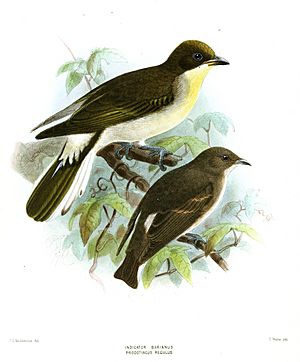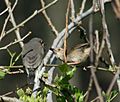Honeyguide facts for kids
Quick facts for kids Honeyguides |
|
|---|---|
 |
|
| Greater honeyguide and brown-backed honeybird |
|
| Scientific classification |
|
| Kingdom: | Animalia |
| Phylum: | Chordata |
| Class: | Aves |
| Order: | Piciformes |
| Infraorder: | Picides |
| Family: | Indicatoridae Swainson, 1837 |
| Genera | |
|
Indicator |
|
Honeyguides are a unique group of birds belonging to the family Indicatoridae. They are also known as 'indicator birds' or 'honey birds'. These birds are found in warm, tropical regions, mainly in Africa, with two species living in Asia.
Honeyguides are famous for their special relationship with humans. Some species will deliberately lead people to wild bee nests. After humans collect the honey, the honeyguides then feast on the leftover beeswax and bee grubs.
Honeyguide Reproduction
Honeyguides have a very interesting way of raising their young. They are known as brood parasites. This means they do not build their own nests or raise their own chicks. Instead, a female honeyguide lays her eggs in the nests of other bird species.
Most honeyguides prefer to lay their eggs in the nests of birds that build nests in holes, such as barbets and woodpeckers. However, some honeyguides, like those in the Prodotiscus group, choose birds that build cup-shaped nests, such as white-eyes or warblers.
When a honeyguide chick hatches, it has a special advantage. The mother honeyguide actually keeps the egg inside her body for an extra day before laying it. This gives her chick a head start in growing compared to the host's chicks.
How Honeyguide Chicks Survive
Honeyguide chicks are born with tiny, sharp hooks on their beaks. These hooks are used to get rid of any competition. Just after hatching, the honeyguide chick will use its sharp beak to puncture the host's eggs or kill the host's newly hatched chicks. This ensures that the honeyguide chick is the only one in the nest and gets all the food and care from the host parents. This behavior is similar to how cuckoo chicks act.
Images for kids
See also
 In Spanish: Indicadores para niños
In Spanish: Indicadores para niños


